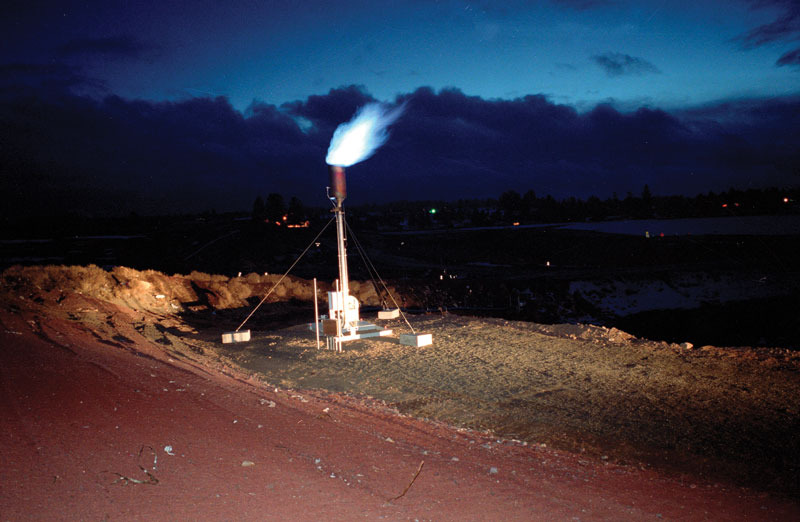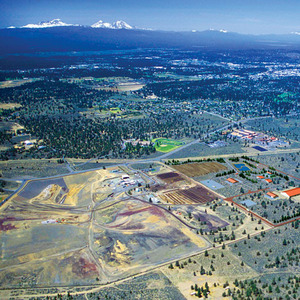Profit in Plug and Play







PHOTO: Deschutes County Department of Solid Waste
April 20, 2015
BY Katie Fletcher
Alternative fuel markets are volatile, as has been realized by the host of waste-to-energy (WTE) projects that have come to fruition and experienced varying feats and failures. For California-based Waste to Energy Group, which stepped into the renewable energy arena around five years ago, deploying a technology that ebbs and flows with market volatility is protection against that unpredictability.
At Knott Landfill in Bend, Oregon, Waste to Energy Group is hoping to soon finalize a WTE project that will be capable of producing a number of renewable fuels. “As the market conditions may change, our technology can plug and play to meet the market conditions,” says company CEO Randy Lutz.
In fact, the company has changed courses a few times since negotiations began in 2011. “It moved from pipeline-quality gas to methanol, and then to ethanol,” Lutz says. “During project development, the market for pipeline gas went through dramatic changes. During the same period of time, our company forged technology alliances, which allowed us to bolt on a number of alternative fuel solutions.”
Should market conditions change in the future, the company can switch to methanol, diesel or back to pipeline gas. “We’re directly adjacent to central Oregon’s natural gas pipeline, and this allows us to supplement, if needed, to guarantee 100 percent production with any of our fuel products,” Lutz added.
Knott Landfill collects about 130,000 tons of waste per year. According to Timm Schimke, director of solid waste for Deschutes County, a landfill gas-to-energy (LFGTE) project was on the county’s radar, but ended up not being economically feasible due to the small amount of landfill gas produced. Traditional development companies gave little interest, but Waste to Energy came in with a unique proposal to try to increase the landfill’s gas production without financial assistance from the county. Schimke says Waste to Energy Group’s proposal, “moved us from a marginal at best prospect, to potentially pretty lucrative prospect for a gas-to-energy project.”
Projects take time, and this one is no exception, especially since the design is unlike most LFGTE projects. “We went out and retained a third-party engineering firm to review the proposal and the contract terms to give us an opinion on what they felt the project looked like,” Schimke says. “It’s out of the box—it takes a little bit of time for the local government to embrace that and decide whether they want to give that a shot.”
Further extending the project’s timeline was the challenge of acquiring funding, which has now been secured through a European investor. “We went through several false starts until we found the means to accomplish our purposes,” Lutz says.
Heat, moisture and oxygen are needed to convert organics into methane. Waste to Energy Group provides a patented process, during which steam is injected into the landfill’s interior, speeding up waste decomposition and producing methane gas. The gas is then washed or scrubbed to remove all the trace toxins, producing a contaminant-free, commercial-grade methane to make liquid fuel—in this case, ethanol after it is cleaned. Since the project uses steam, only one-sixteen hundredth of the amount of water is needed when compared to other projects that inject water to increase methane production. “When you apply steam to the landfill mass, the organics just take off,” Lutz says. “They have the heat, moisture and oxygen they want, and convert very rapidly in a controlled environment.”
A landfill profile using a Piezo-Penetrometer Test finds the opportune places to drill wells for steam injection. The PPT analysis includes a 3D computer rendering of what is in the landfill and where the gas, water and vacuum pockets are. The system also monitors how the process is working once operational.
Although this will be Waste to Energy’s first project using this process at a landfill, a pilot study was conducted at Miramar in Southern California. The company now has four other landfills scheduled to implement this same technology.
Last January, county commissioners approved the project by putting together an 18-month contract to have the project completed and operational within that timeframe. Since then, the company has been given the right to proceed. This gives the project the go-ahead to begin with the initial engineering and PPT analysis in April, which will take three months to complete. While this is occurring, there are two other permits that must be acquired. A site plan review will occur through the Community Development Department for a land use permit. Once complete, a land use compatibility statement will be needed for the Department of Environmental Quality application to acquire a research, development and demonstration permit. Schimke estimates that each permit will take a minimum of 60 to 90 days to obtain, one needed before the other permitting process can begin.
Once all the permitting is in place, Lutz estimates they’ll need about nine months for construction. Waste to Energy Group’s engineering, procurement and construction contractor will be Swinerton Engineering and Construction. The project has a $20 million capex. Some funds will go toward purchasing equipment, such as a fuel collection system, scrubbers, ethanol technology, piping and a steam boiler—a portion of which will be fueled with landfill gas. Waste to Energy Group does not own any of the technology. Rather, it partners with providers. The patent holder for the steam injection technology is STI Engineering in Southern California, and the ethanol technology is proprietary, licensed specifically to Waste to Energy.
When all is said and done, the estimated production capacity of ethanol totals around 11 MMgy, which will be sold as an additive to other fuel products. “The operational costs make it very competitive when compared to the traditional corn ethanol-type facilities,” Lutz says.
The county signed a 15-year lease with the company, and is set to receive a percentage of the gross revenue from the project. Besides revenue from fuel sales, the project will recover landfill space, extending the life of the landfill. Schimke hopes another future benefit the project could yield is allowing the landfill site to treat portions of the waste stream before its dumped into the landfill. He foresees the possibility of waste, such as green material from the surrounding Oregon forests, treated through anaerobic digestion or gasification before it hits the landfill to achieve some level of volume reduction. “The residuals may end up in the landfill, but it’d be a much smaller volume than if we just put it in there raw,” Schimke says.
The county does have a few opponents to the project, as there is development near the landfill, including a middle school across the road. Community members question the need to artificially increase the amount of gas being produced, but Schimke says it will only be a matter of time before the landfill will be producing those volumes anyway. “It seems to make sense to me to take advantage of the value of the gas, and move away from that old 1950s technology—simple flaring—which most people agree is not the best way to go, and incorporate a modern, aggressive, much better gas management program,” Schimke says.
Current progressing development is considered phase one, with the possibility of two additional phases in the future. “There are other projects in the county that we are looking forward to participating with,” Lutz says.
One area to address is Deschutes County’s nonmunicipal demolition landfill, which is an unlined facility with instability issues. Steam injection could potentially be used to stabilize or remediate the land for the opportunity to use the site in another way. If the waste could be treated in an unlined area, Schimke believes that would be beneficial. Waste to Energy will try to prove it can treat an unlined area to Oregon’s DEQ. “The steam stays in a vapor state and doesn’t condense and travel back to the bottom of the landfill,” Lutz says. “This allows us to do any landfill, whether it is sealed or not, and that is very different than any other landfill or process going on in the U.S. right now.”
Subsequent phases depend on the success of phase one and Oregon’s DEQ feeling comfortable enough to proceed. “I see this as a stepping stone to other things in the future that will change the way we manage waste,” Schimke says.
Author: Katie Fletcher
Staff Writer, Biomass Magazine
701-738-4920
kfletcher@bbiinternational.com
Advertisement
Advertisement
Upcoming Events





